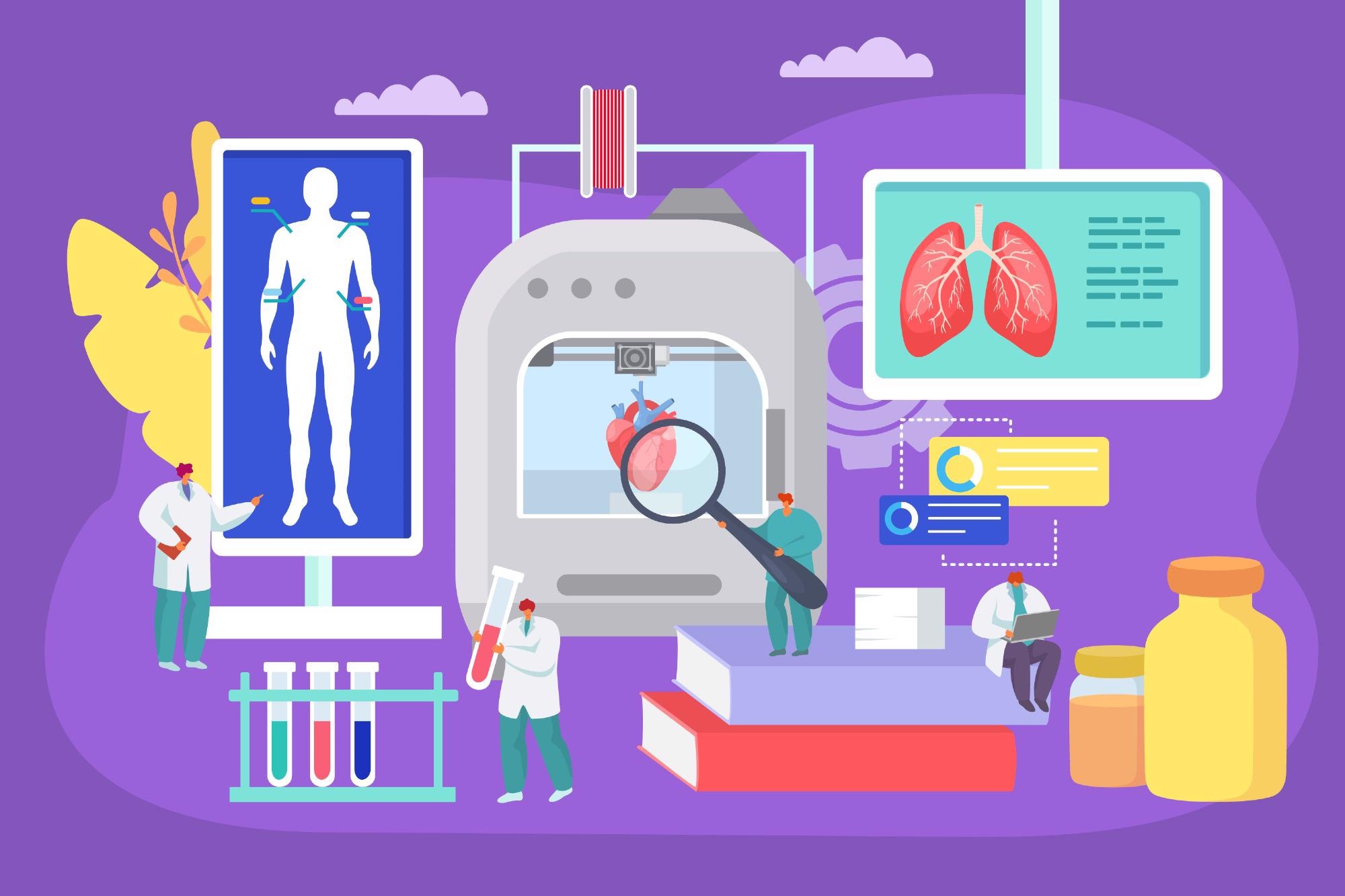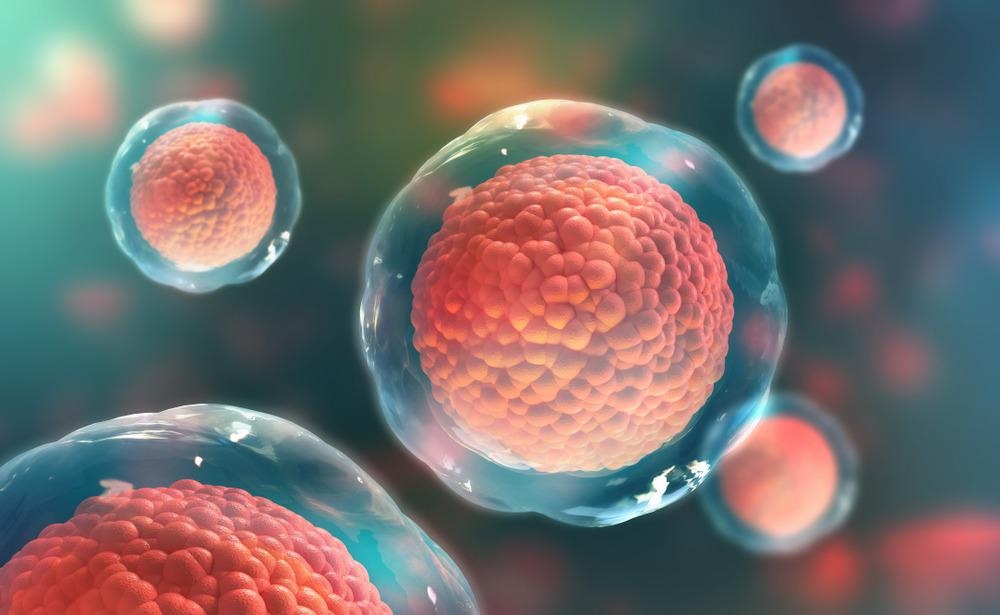Dr. Amy Gelmi explores new approaches to patient-tailored tissue engineering using stem cells. Professor Leslie Yeo's research applies acoustically and electrokinetically driven microfluidics for engineering and biological applications. This exciting research was the result of a collaboration combining Professor Yeo’s acoustic wave generation device and Dr. Gelmi’s interest in using external stimulation to control adult stem cell fate.
Tissue engineering is a field that has seen great advancements in recent years but there are still some challenges that need to be overcome. What are some of the biggest challenges currently faced in regrowing bones?
Generating new bone tissue in large enough volume to replace things like an excised tumor is difficult. Additionally, there is always the risk of the immune system rejecting an implant or new tissue. Integrating the new tissue or implant with the existing bone is also a challenge.

Image Credit: KittyVector/Shutterstock.com
Currently, experimental processes used to regrow bones have struggled with mass production and its adoption within clinical settings. What are some of the limitations observed in current processes?
The number of stem cells required to develop into a useful volume of bone is very high. Harvesting and growing stem cells into bone is quite time-consuming. More effective techniques usually involve putting the cells into supportive scaffolds or structures, so they can grow in and around to create new tissue. This may not always be a good match for the native bone, however.
In your latest research, you used sound waves to turn stem cells into bone cells quickly and efficiently. Can you describe how you carried out this research?
In this study, we coupled a ‘surface acoustic wave’ device to our cell culture dishes. The device is cheap and easy to make and sends high-frequency sound waves (way beyond human hearing level!) which move across the stem cells. As stem cells can turn into many kinds of cells, if we want them to turn into bone cells we have to ‘convince’ them to turn into bone specifically.
We looked to see how quickly the stem cells began to show signs of becoming bone cells and found they made their decision much earlier than ‘conventional’ methods (feeding the stem cells specific biochemicals). They also showed a ‘stronger’ response when turning into bone cells when compared to the conventional methods.
We looked into the response of the stem cells to see if we could understand why this was happening and found that the stem cells were ‘feeling’ the pressure created by the high-frequency sound waves. This pressure is what triggered the stem cells to begin to turn into bone cells.
Your treatment was also effective on multiple types of cells including fat-derived stem cells. Why did you choose to test this treatment on different cell types?
You can actually find these stem cells in several different parts of the body- bone marrow, fat, even in your teeth.
By applying our treatment to stem cells of different sources, we demonstrated that in future applications patients won’t be limited to only providing bone marrow, for example, for this kind of tissue engineering. Additionally, liposuction to extract fat-based stem cells can be less invasive and painful compared to a bone marrow extraction.

Image Credit: Yurchanka Siarhei/Shutterstock.com
The technique that you have developed would help millions of people who have lost bone due to cancer or degenerative disease. What would this mean to these patients?
We hope this discovery can lead to further development and improvement in the area of patient-specific tissue engineering; imagine being able to grow custom bone tissue as needed for patients, using their own stem cells so you can avoid an immune system response when reintegrating the new tissue. There wouldn’t be a waitlist for donated tissue or problems with rejection after the reintegration.
What further research needs to be carried out before this technique can be used within clinical settings? Are you hopeful that with continued advancements into tissue engineering, we will one day see this technique being used to help patients regrow bone?
We need to further research the mature bone tissue these stem cells produce once treated, potentially moving to animal models to prove this method produces functional bone. We also hope to use a wider variety of patient-derived stem cells, in particular using ‘older’ donor stem cells to observe how well this treatment works on aged stem cell sources, as this would potentially be a large demographic this treatment could apply to.
Are there any other applications that your sound wave-generating device could be used for?
We have employed the sound wave devices for manipulating liquids and biomolecules at micron and nanometer scales to develop microfluidic devices for point-of-care diagnostics and inhaled drug delivery and vaccination. An example is a portable next-generation nebulization platform for pulmonary delivery of biologics (DNA, RNAi, peptides, proteins) and stem cells.

Image Credit: Andrey Keno/Shutterstock.com
What are the next steps for you and your research into bone repair?
Our next steps are to use our treatment to ‘condition’ the stem cells before integrating them into a supportive implant or scaffold; for example, loading the treated stem cells into a ‘bio-ink’ and then 3D printing a structure for the stem cells to grow into bone tissue.
As our technique ‘primes’ the stem cells to turn into bone, we must take advantage of the window of opportunity to get the stem cells into the best possible environment before they begin forming bone.
About Dr. Amy Gelmi
Dr. Amy Gelmi is a Vice Chancellor’s Research Fellow at RMIT University, where she has established her research group to focus on using external stimulation to control stem cell fate..jpg)
Dr. Gelmi is currently a lead chief investigator on an ARC Discovery Project for the stimulation of stem cells for tissue engineering. Dr. Gelmi received her Ph.D. from the University of Wollongong, and prior to joining RMIT Dr. Gelmi held a Marie Skłodowska-Curie Fellowship at Imperial College London.
About Professor Leslie Yeo
Leslie Yeo is a Distinguished Professor of Chemical Engineering at RMIT. Following a Ph.D. from Imperial College London in 2002 and a postdoctoral stint at the University of Notre Dame USA, he assumed faculty positions at Monash University and RMIT where he held the Australian Research Council’s Australian Research Fellowship and Future Fellowship from 2009 to 2017..jpg)
Leslie is co-author of the book Electrokinetically Driven Microfluidics & Nanofluidics, author of over 250 publications and 25 patent applications, Editor-in-Chief of Biomicrofluidics, and Associate Editor of Frontiers in Bioengineering & Biotechnology. Leslie’s research interests primarily center around high-frequency acoustics for diverse applications across microfluidics, drug delivery and nanomedicine, nanomaterials synthesis, and mechanobiology.